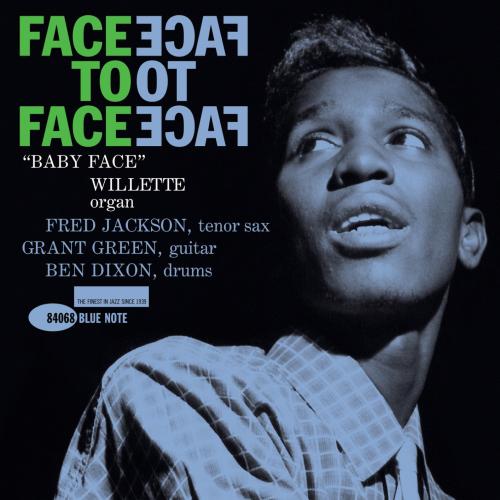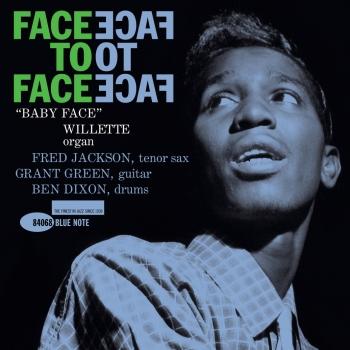
Face To Face (Remastered) Baby Face Willette Quartet
Album Info
Album Veröffentlichung:
2019
HRA-Veröffentlichung:
07.06.2019
Das Album enthält Albumcover
Entschuldigen Sie bitte!
Sehr geehrter HIGHRESAUDIO Besucher,
leider kann das Album zurzeit aufgrund von Länder- und Lizenzbeschränkungen nicht gekauft werden oder uns liegt der offizielle Veröffentlichungstermin für Ihr Land noch nicht vor. Wir aktualisieren unsere Veröffentlichungstermine ein- bis zweimal die Woche. Bitte schauen Sie ab und zu mal wieder rein.
Wir empfehlen Ihnen das Album auf Ihre Merkliste zu setzen.
Wir bedanken uns für Ihr Verständnis und Ihre Geduld.
Ihr, HIGHRESAUDIO
- 1 Swingin' At Sugar Ray's (Remastered) 06:32
- 2 Goin' Down (Remastered) 07:24
- 3 Whatever Lola Wants (Remastered) 07:19
- 4 Face To Face (Remastered) 06:14
- 5 Somethin' Strange (Remastered) 06:41
- 6 High 'N Low (Remastered) 07:05
Info zu Face To Face (Remastered)
Releasing his debut album, Face To Face, in 1961, this son of a preacher rode in on the wave of aspiring jazz organists that proliferated in the wake of Jimmy Smith's breakthrough in the late 50s. Grant Green was happy to be a sideman on Roosevelt "Baby Face" Willette's maiden session and he was joined by drummer Ben Dixon. To give the studio date a different flavor from Grant's First Stand, saxophonist Fred Jackson, noted for his raspy tone, was added to expand the group to a quartet.
As "Swingin' At Sugar Ray's" reveals, Willette attacked the keyboard with a percussive ferocity, even though his touch was exceptionally light and staccato-like. The evocative late-night blues of "Goin' Down" then gives way to the lone cover, a soul jazz deconstruction of "Whatever Lola Wants." The title tune is driven by a catchy, blues-based riff while the driving "Somethin' Strange" is another blues-drenched number played with great energy and enthusiasm. Earthy blues elements are also perceptible in vigorous closer, "High 'N Low." For fans of soulful organ jazz, Face To Face was a significant release because it introduced an exciting new Hammond B3 practitioner – one who had his own distinctive sound and brought a new dynamism to the genre.
"Mastered directly from the original analog master tapes by Kevin at his incredible facility called Cohearent Mastering. We go about it in the exact same way that we did for so many years for the Music Matters Blue Note reissues. We do not roll off the low end, boost the top or do any limiting of any kind. We allow the full glory of the original Blue Note masters to come though unimpeded! Short of having an actual time machine, this is as close as you can get to going back and being a fly on the wall for an original Blue Note recording session." (Joe Harley)
Baby Face Willette, organ
Fred Jackson, tenor saxophone
Grant Green, guitar
Ben Dixon, drums
Digitally remastered
Baby Face Willett
Highly underrated as a soul-jazz organist due in large part to a scanty discography, Baby Face Willette remains a somewhat mysterious figure, a quiet, reserved man who disappeared from the jazz scene after the first half of the '60s. Born Roosevelt Willette on September 11, 1933 (there is some dispute as to whether he was born in New Orleans or Little Rock), his parents were heavily involved in the church, and thus his music had deep roots in gospel. Studying with his pianist uncle Fred Freeman, Willette played in several gospel groups as a teenage pianist and soon branched out into R&B, which gave him the opportunity to tour the country with numerous outfits. He settled in Chicago for a time and began concentrating on jazz organ in 1958, but didn't make much headway on the scene until he moved to New York and met Blue Note mainstays like Lou Donaldson and Grant Green. He played on Donaldson's Here 'Tis and Green's Grant's First Stand in January 1961, and the same month recorded his own debut, Face to Face. A few months later, he recorded the follow-up, Stop and Listen, which is generally regarded as his best work. After that initial burst of activity, Willette went on to form his own regular trio in 1963, and moved over to the Argo label, where he recorded two sessions in 1964: Mo-Roc and Behind the 8 Ball. He had a regular engagement at a South Side Chicago lounge from 1966-1971 (approximately), but largely vanished from the jazz scene afterwards and died in obscurity. (Steve Huey, AMG)
Dieses Album enthält kein Booklet











